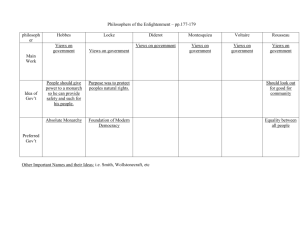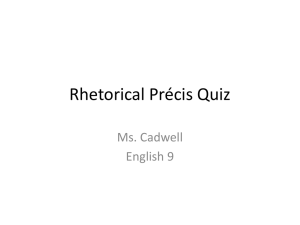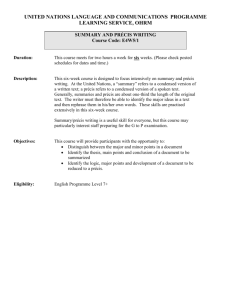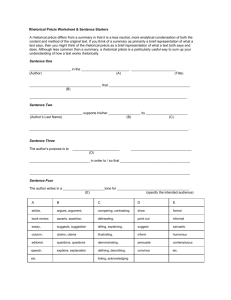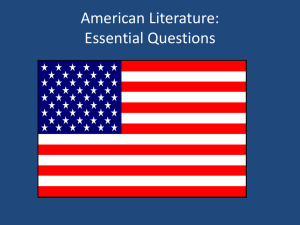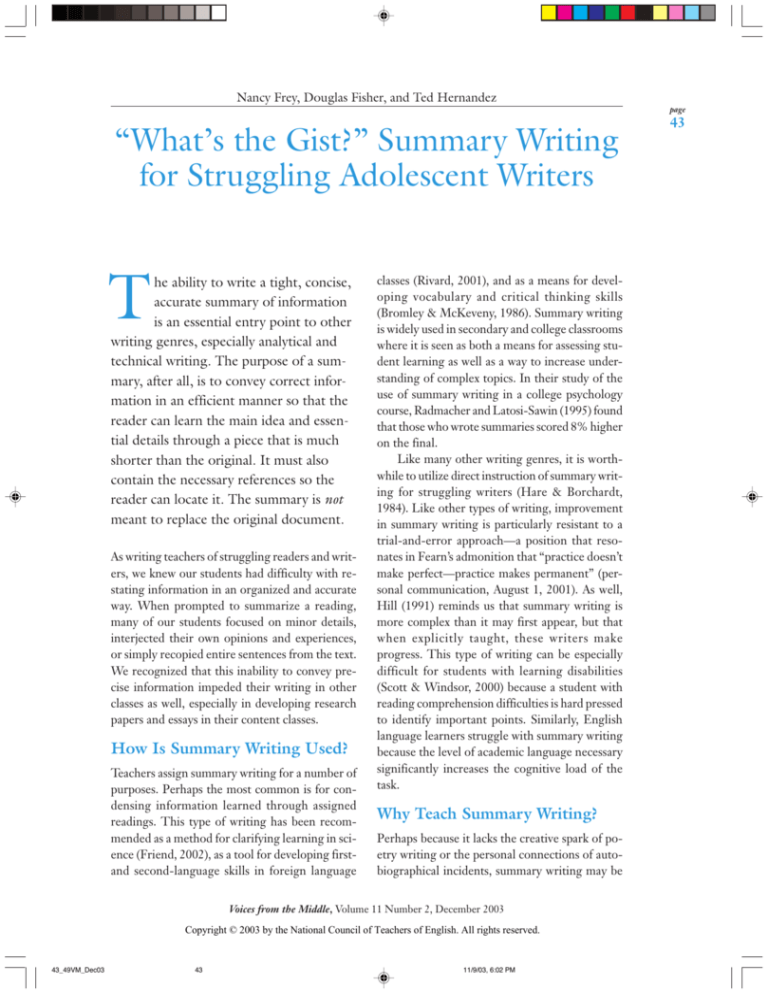
Frey, Fisher, and Hernandez
“What’s
the Gist?”
Summary
for Struggling Adolescent Writers
Nancy| Frey,
Douglas
Fisher,
andWriting
Ted Hernandez
page
“What’s the Gist?” Summary Writing
for Struggling Adolescent Writers
T
he ability to write a tight, concise,
accurate summary of information
is an essential entry point to other
writing genres, especially analytical and
technical writing. The purpose of a summary, after all, is to convey correct information in an efficient manner so that the
reader can learn the main idea and essential details through a piece that is much
shorter than the original. It must also
contain the necessary references so the
reader can locate it. The summary is not
meant to replace the original document.
As writing teachers of struggling readers and writers, we knew our students had difficulty with restating information in an organized and accurate
way. When prompted to summarize a reading,
many of our students focused on minor details,
interjected their own opinions and experiences,
or simply recopied entire sentences from the text.
We recognized that this inability to convey precise information impeded their writing in other
classes as well, especially in developing research
papers and essays in their content classes.
How Is Summary Writing Used?
Teachers assign summary writing for a number of
purposes. Perhaps the most common is for condensing information learned through assigned
readings. This type of writing has been recommended as a method for clarifying learning in science (Friend, 2002), as a tool for developing firstand second-language skills in foreign language
classes (Rivard, 2001), and as a means for developing vocabulary and critical thinking skills
(Bromley & McKeveny, 1986). Summary writing
is widely used in secondary and college classrooms
where it is seen as both a means for assessing student learning as well as a way to increase understanding of complex topics. In their study of the
use of summary writing in a college psychology
course, Radmacher and Latosi-Sawin (1995) found
that those who wrote summaries scored 8% higher
on the final.
Like many other writing genres, it is worthwhile to utilize direct instruction of summary writing for struggling writers (Hare & Borchardt,
1984). Like other types of writing, improvement
in summary writing is particularly resistant to a
trial-and-error approach—a position that resonates in Fearn’s admonition that “practice doesn’t
make perfect—practice makes permanent” (personal communication, August 1, 2001). As well,
Hill (1991) reminds us that summary writing is
more complex than it may first appear, but that
when explicitly taught, these writers make
progress. This type of writing can be especially
difficult for students with learning disabilities
(Scott & Windsor, 2000) because a student with
reading comprehension difficulties is hard pressed
to identify important points. Similarly, English
language learners struggle with summary writing
because the level of academic language necessary
significantly increases the cognitive load of the
task.
Why Teach Summary Writing?
Perhaps because it lacks the creative spark of poetry writing or the personal connections of autobiographical incidents, summary writing may be
Voices from the Middle, Volume 11 Number 2, December 2003
Copyright © 2003 by the National Council of Teachers of English. All rights reserved.
43_49VM_Dec03
43
11/9/03, 6:02 PM
43
Frey, Fisher, and Hernandez | “What’s the Gist?” Summary Writing for Struggling Adolescent Writers
page
44
overlooked in many middle school classrooms.
After all, the restatement of the main points of a
longer text may be viewed by teachers and students alike as an academic exercise (and a particularly boring one at that) with few benefits beyond
accountability for reading assignments. However,
the ability to summarize text accurately and efficiently without plagiarizing is a core competency
for other writing genres. For instance, research
papers are required to have a review of the literature on the topic. A well-crafted persuasive essay
must contain factual information that forwards the
creative spark of poetry writer’s position. And certainly an analytic piece of
writing or the personal writing must necessarily
connections of autobio- describe the person, event,
process, or phenomenon
graphical incidents, sum- being analyzed before
mary writing may be over- moving to the critical position assumed by the stulooked in many middle dent writer. Success in
school classrooms. each of these writing
genres is predicated on the
accuracy of the information cited by the writer to
support the thesis.
Perhaps because it lacks the
Types of Summary Writing
There are two types of summaries used by student writers, and each has its unique purposes. The
first is the précis, a brief summary of another text
that contains the main points but little embellishment. It is usually six to eight sentences in length,
although a short reading may reduce the number
of necessary sentences to four.
A second type is the evaluation summary. Like
the précis, it is brief and focuses on the thesis of
the reading. Unlike the précis, it concludes with a
statement of the student writer’s opinions and insights. The most common kind of evaluation summary is the traditional book report containing both
a summary of the book as well as recommendations and criticisms.
All summaries possess three common characteristics:
• they are shorter than the original piece;
• they paraphrase the author’s words; and
• they focus on the main ideas only.
Although we addressed both forms of summaries over the course of the year, this article describes our précis writing unit. We began the
semester with précis writing as one of five Short
Cues used nearly every day with the class (Fearn
& Farnan, 2001). In their book, the authors describe these practices (précis, Power Writing, process pieces, word limiters, and directions) as
“writing prompts that promote whole pieces of
writing in short space and time” (p. 67). They argue that the ability to “write short” means that
students must write precisely, choosing their words
carefully to convey the central themes without
compromising the integrity of the original work.
This approach of “writing short” fits well with
our student needs. The 32 adolescents in our class
attend an urban public school where 74% of the
student body has a home language other than
English and 100% qualify for free or reduced
lunch. Half of our students were classified as ESL
students and four had Individual Education Plans
(IEP) that identified them as having a disability.
At the beginning of the semester, the class averaged 96 words on a 5-minute timed writing sample
and used 12.89 words per sentence. This added
up to a group of students with little stamina for
sustained writing. We knew we would have to start
small.
GIST Summary Writing
We were cautious in our approach to summary
writing. We knew that it was not sufficient to simply “cause” writing through writing prompts alone.
Although we are not in favor of formula writing
(there are too many “hamburger paragraphs” in
the world already), we knew that our students
would benefit from a systematic method of précis
writing. We were also cognizant of the research
of Stein and Kirby (1992) who recommend that
the text be available when teaching students who
are not yet facile at writing summaries rather than
Voices from the Middle, Volume 11 Number 2, December 2003
43_49VM_Dec03
44
11/9/03, 6:02 PM
Frey, Fisher, and Hernandez | “What’s the Gist?” Summary Writing for Struggling Adolescent Writers
page
using recall methods alone to create a précis.
One technique that appealed to us was Generating Interaction between Schemata and Text
(GIST), a collaborative learning strategy used to
increase comprehension of expository texts
(Cunningham, 1982; Herrell, 2000). The text is
divided into sections that serve as stopping points
for clarification and writing. At each stop point,
the meaning of the passage is discussed, vocabulary is explained, and a single summary sentence
is negotiated. The cycle is repeated until the entire text has been read. The list of sentences generated by the students serves as a précis for the
longer text. A list of the steps for introducing
GIST appears in Table 1.
Survivor Writing
Although we had identified a method for instructing students on précis writing, we still needed to
find engaging texts. Because our class was a writing class, we were not bound to one content area
for our reading materials. Instead, we opted to
intersperse many nontraditional texts to motivate
students. We quickly settled on a “Survivor” theme
to parlay the ready-made interest of the ubiquitous game show into a conduit for in-class writing
instruction. We opened the unit with two readings on Phineas Gage, the man who survived a
horrific railroad accident in 1848 that blew an iron
tamping rod through his skull. While his physical
wounds healed, the terrible injury changed his
personality profoundly, paving the way for the
brand-new study of the brain as the source of personality. A complete list of the readings used in
this unit can be found in Figure 1.
The reading was photocopied so that students
could follow along and underline key words and
phrases while we displayed it on the overhead. Stop
points were identified and marked on the text in
advance. After each section of the passage was read,
we stopped to discuss the content and unfamiliar
vocabulary. We then used a think-aloud strategy
(Davey, 1983) to model the selection and elimination of various facts for use in our one summary
sentence. We charted these ideas on the board,
then experimented with different wordings until
we could combine the important ideas into one
sentence. This sentence was written on a sentence
strip and displayed in a pocket chart. This instruction cycle was repeated until the entire passage
had been read. The final step was to reread the
list of sentences to check for understanding. At
Table 1. Sequence of Steps for Direct Instruction of GIST
1.
Distribute copies of a short text (1–11/2 pages). Each text should be divided into four or five sections that
represent logical summarizing points, indicated by a line and the word “STOP” in the margins.
2.
Explain GIST: students read a portion of a text, stop, and write a sentence that summarizes the “gist” of the
passage. At the end of the text, students will have written four or five sentences, or a concise summary of the
text.
3.
Introduce the text to be read, build prior knowledge, and discuss key vocabulary. Read aloud the first passage
of the text while students read along silently.
4.
Lead class discussion about important facts from the passage, writing their ideas on the board.
5.
Lead class discussion about how to formulate ideas into a sentence, allowing students to share ideas and
negotiate these ideas to craft an accurate and precise sentence.
6.
Write the agreed-upon sentence on the board, numbering it #1. Students write the sentence in their journals.
7.
Read aloud the second passage, following same sequence above, and numbering the agreed-upon sentence #2.
Repeat cycle until text is finished.
8.
Discuss how the class has condensed a page of text into a limited number of sentences. Reread the series of
sentences to check for meaning. Make any changes necessary so that it serves as a concise written summary.
Voices from the Middle, Volume 11 Number 2, December 2003
43_49VM_Dec03
45
11/9/03, 6:02 PM
45
Frey, Fisher, and Hernandez | “What’s the Gist?” Summary Writing for Struggling Adolescent Writers
page
46
this time, we edited any sentences that could benefit from the use of transitions to make the paragraph flow more smoothly. Students were
surprised to see how easily a précis could be constructed using this method.
During subsequent lessons, we paid close attention to sentence combining and the use of dependent clauses. The avalanche readings were
especially useful for this because we introduced a
newspaper story of a recent accident. This text
structure was different from the ones we had previously read about Phineas Gage because it used
the inverted pyramid structure common to the
journalistic trade (Ryan, 1995). We first taught this
text structure, and then showed how we divided
the text so that the bulk of the summary sentences
would be generated in the first half of the article.
As we read and created a list of ideas for use in
Texts for Getting Started
Fleischman, J. (2002). Phineas Gage: A gruesome but true story about brain
science. New York: Houghton Mifflin.
McDonald, J. (Writer), Hoppe, B. (Writer & Director). (1997). Avalanche!
[Television series episode]. In B. Hoppe (Producer), Nova. New York
and Washington, DC: Public Broadcasting Service.
National Snow and Ice Data Center. (n.d.). Avalanche! Surviving an
avalanche. Retrieved February 8, 2003, from http://nsidc.org/snow/
avalanche/#WHY
Seven skiers dead in second deadly B.C. avalanche in a month. (February 1,
2003). Retrieved February 8, 2003 from http://www.csas.org/
Incidents/2002-03/20030201-Canada.html#OFFICIAL
Shreeve, J. (1995). What happened to Phineas? Retrieved November 12,
2002 from htp://www.mc.maricopa.edu/~reffland/anthropology/
origins/phineas.html
Texts for Collaborative Writing
Piven, B., & Borgenicht, D. (1999). The worst-case scenario survival
handbook. San Francisco: Chronicle.
• How to escape from quicksand (pp. 18–19)
• How to escape from a mountain lion (pp. 54–56)
• How to wrestle free from an alligator (pp. 57–59)
• How to survive if your parachute fails to open (pp. 137–139)
Texts for Assessment
Stafford, M. (2003, January 29). Teen ejected in wreck saved by utility
wires. Fort Worth Star-Telegram, p. A4.
Figure 1. Survival Texts for Summary-Writing Lessons
summary sentences, we attended to the use of complex sentences with dependent clauses (and their
accompanying commas) as a way of packing sentences with more than one idea.
Our next step was to create opportunities to
write a précis more independently. Capitalizing
on the survivor theme, we showed a 10-minute
segment from the PBS broadcast “Avalanche!” (see
McDonald, Figure 1). This video clip featured
footage and interviews with extreme skiers who
braved treacherous slopes for sport. The presence
of these skiers sometimes triggers an avalanche,
which was ably explained through visual diagrams
and dramatic footage. We stopped the video three
times at logical points and asked students to write
one summary sentence in their writer’s notebook.
Frederico’s précis of the video segment (with errors intact; all student names are pseudonyms)
read:
Weak layers of snow Heavy layers of snow pile one
the weak ones up on the weak layers near the bottom,
causing it to slide and begin an avalanch. Most avalanches are triggered by humans, due to ignorance or
arrogance. Many times these people take risks because
they’re so pumped up that they dont pay attention to
the warnings.
As his teachers, we were particularly heartened to
see the words and phrases he crossed out in an
effort to create complex sentences that would convey more information. A review of the previous
15 pages of his notebook before this writing
showed that he had never before engaged in selfediting in this class.
After practicing the précis short cues for several weeks, we were ready to move into collaborative groups where students could negotiate
sentences with one another. We selected readings
from The Worst-case Scenario Survival Handbook (see
Piven & Borgenicht in Figure 1) because of their
connection to our theme and because they offered
yet another teaching point we needed to address.
We had seen a bit of plagiarism in some of the
précis writing we were getting from the students
and realized that we had not taught them how to
avoid it. These readings gave us the opportunity
to address the issue directly through discussion of
Voices from the Middle, Volume 11 Number 2, December 2003
43_49VM_Dec03
46
11/9/03, 6:02 PM
Frey, Fisher, and Hernandez | “What’s the Gist?” Summary Writing for Struggling Adolescent Writers
page
the format of the text. All of these readings are
constructed as lists, complete with numbered steps.
The overall number of words is reduced in this
format, making it even easier to use the authors’
words because there are so few to choose from.
We shared a general rule with our class—no more
than four words in a row can be taken directly from
the text. Although this was a somewhat arbitrary
figure, we hoped that it would encourage them to
pay attention at the word level.
We divided the class into four heterogeneous
groups so that each had at least one strong writer
and one weaker writer. The texts, complete with
stop points, were distributed, and we sat in on discussions. A scribe for the group was responsible
for recording the agreed sentences.
Frederico’s group wrote about what to do if
your parachute failed to open:
When your parachute won’t open, signal another
jumper to come towards toward you and when they
do hook arms. Because you will be traveling at about
130 miles an hour, you will not be able to grab on
normaly and will have to hold on to the straps of the
other jumper and when it opens there may be a chance
you’ll brake your arms. To have a safe landing, try to
land on water (if any) and if their isn’t any watch out
for power lines. Now modern chutes are made to open
even if you make a mistake, but the reserve chute must
be packed correctly.
Marco’s group wrote about what to do if you
are about to be attacked by a cougar:
When you meet a cougar do not run or crouch,
and use things to make yourself bigger. If you are with
a child pick them up so you can look bigger and back
up slowly, or wait until it leaves. If it acts like it’s going to attack, throw rocks. Fight back if you are attacked and hit him in his head using rocks and sticks.
Julia’s group had the task of explaining what
measures to take if you ever need to wrestle an
alligator. They wrote:
Cover his eyes or his nose—these that’s were he’s weak.
If it gets you in his jaws [inserted] puch punch him in
the nose and don’t let him shake you. Because alligators have a lot of germs in there mouth, go get to a
doctor immediately. To avoid an attack, don’t feed
them and don’t mess with the babies and don’t try to
touch them.
47
Not surprisingly, the writing activity created
quite a bit of conversation. After each group had
written their survivor advice, they taught the rest
of the class what to do if they found themselves in
the same unfortunate circumstances. This presentation of information also allowed their classmates
to ask clarifying questions
about summaries that were The ability to write accunot written clearly or conrately and efficiently for the
tained too little information to be useful. In some purpose of reporting inforcases, sentences were remation is a gateway skill for
written to reflect the feedother types of writing,
back of their peers.
At this point, we felt
particularly research reports
like it was time to assess
their understanding of and persuasive essays.
summary writing. In keeping with our survivor theme, we chose one of the
most extraordinary stories we had come across.
Assessing Summary Writing
The piece we chose for the assessment offered
many of the elements we had taught in the unit.
First, it was a newspaper article that offered the
inverted pyramid text structure we had seen before. Second, it had a photograph to accompany
the story, like many of the pieces we had previously written about. It was of a similar length to
the other stories we had read and discussed, and
of course it recounted a survivor’s tale. Entitled
“Teen ejected in wreck saved by utility wires” (see
Stafford in Figure 1), the story described the fortunes of Joe Thompson III of Kansas City, Missouri, who was catapulted into the overhead wires
after a traffic accident.
Students were required to write a summary
of the article, but were not mandated to use the
GIST frame to create one. In order to ensure that
students could make decisions about what information to include and exclude, the copies of the
text did not include stop points. We used a rubric
to assess their work (see Table 2) and were pleased
to see that after three weeks of instruction, most
Voices from the Middle, Volume 11 Number 2, December 2003
43_49VM_Dec03
47
11/9/03, 6:02 PM
Frey, Fisher, and Hernandez | “What’s the Gist?” Summary Writing for Struggling Adolescent Writers
page
48
students had mastered the art of summary writing
and gotten the “gist” of the story.
ity” model (Pearson & Fielding, 1991) at both the
micro- and macro-level for this unit. At the micro-level, we began with multiple lessons featuring direct instruction about writing summaries,
followed by guided practice as students tried this
new strategy for themselves. Over the course of
several weeks, we incrementally moved their writing to a more independent phase, thus ensuring
that they had access to scaffolding and coaching.
At the macro-level, the positioning of summary
writing within the curriculum mirrored a gradual
release model in writing (Fisher & Frey, 2003)
because it utilized a model (GIST) as a means for
moving students to independent writing.
The purpose of summary writing instruction
does not outweigh the need to make the lessons
interesting. By grounding the unit in a popular
theme that appealed to adolescents, we attempted
to motivate them to engage in the act of memorable précis writing. By gaining and maintaining
Conclusion
The ability to write accurately and efficiently for
the purpose of reporting information is a gateway
skill for other types of writing, particularly research
reports and persuasive essays. However, some
middle school writers may struggle with this writing genre because they have difficulty locating
pertinent information and rephrasing it in their
own words. One form of summary writing, called
the précis, offers the opportunity to focus on these
aspects of writing. In examining both the skills of
our students and our philosophy of writing instruction as a deliberate act rather than just an activity
to be launched, we used the GIST strategy
(Cunningham, 1982; Herrell, 2000) as a way to
scaffold instruction in writing a well-crafted précis.
We utilized a “gradual release of responsibil-
Table 2. Rubric for Assessing Summary Writing
Name: _______________________________________
Date: ________________________________________
4
Summary Title: ________________________________
Period: _______________________________________
3
2
Length
6-8 sentences
9 sentences
10 sentences
11+ sentences
Accuracy
All statements
accurate and verified
by story
Most statements
accurate and verified
by story
Some statements
cite outside information or opinions
Most statements cite
outside information
or opinions
Paraphrasing
No more than 4
words in a row taken
directly from story
One sentence
contains more than
4 words in a row
taken directly from
story
Two sentences
contain more than 4
words in a row taken
directly from story
3+ sentences contain
more than 4 words
in a row taken
directly from story
Focus
Summary consists of
main idea and
important details
only
Summary contains
main idea and some
minor details
Summary contains
main idea and only
minor details
Main idea of story is
not discussed
Conventions
No more than one
punctuation,
grammar, or spelling
error
2-3 punctuation,
grammar, or spelling
errors
4-5 punctuation,
grammar, or spelling
errors
6+ punctuation,
grammar, or spelling
errors
Overall grade: __________
Comments:
Voices from the Middle, Volume 11 Number 2, December 2003
43_49VM_Dec03
1
48
11/9/03, 6:02 PM
Frey, Fisher, and Hernandez | “What’s the Gist?” Summary Writing for Struggling Adolescent Writers
page
their attention, an essential but somewhat dry form
of writing can be transformed into an appealing
unit that will leave them with an understanding of
how to report the “gist” of a reading.
References
Bromley, K. D., & McKeveny, L. (1986). Précis writing:
Suggestions for instruction in summarizing.
Journal of Reading, 29, 392–395.
Cunningham, J. (1982). Generating interactions
between schemata and text. In J. A. Niles & L. A.
Harris (Eds.), New inquiries in reading research
and instruction (pp. 42–47). Washington, DC:
National Reading Conference.
Davey, B. (1983). Think aloud: Modeling the cognitive
processes for reading comprehension. Journal of
Reading, 27, 44–47.
Fearn, L., & Farnan, N. (2001). Interactions: Teaching
writing and the language arts. Boston: Allyn &
Bacon.
Fisher, D., & Frey, N. (2003). Writing instruction for
struggling adolescent writers: A gradual release
model. Journal of Adolescent and Adult Literacy,
46, 396–407.
Friend, R. (2002). Summing it up. Science Teacher,
69(4), 40–43.
Guido, B., & Colwell, C. G. (1987). A rationale for
direct instruction to teach summary writing
following expository text reading. Reading
Research and Instruction, 26, 89–98.
Hare, V. C., & Borchardt, K. M. (1984). Direct
instruction of summarization skills. Reading
Research Quarterly, 20, 62–78.
Herrell, A. L. (2000). Fifty strategies for teaching
English language learners. Upper Saddle River, NJ:
Merrill/Prentice-Hall.
Hill, M. (1991). Writing summaries promotes thinking
and learning across the curriculum—but why are
they so difficult to write? Journal of Reading, 34,
536–539.
Pearson, P. D., & Fielding, L. (1991). Comprehension
instruction. In R. Barr, M. L. Kamil, P. Mosenthal,
& P. D. Pearson (Eds.), Handbook of reading
research (Vol. II, pp. 815–860). Mahwah, NJ:
Lawrence Erlbaum.
Radmacher, S. A., & Latosi-Sawin, E. (1995). Summary
writing: A tool to improve student comprehension
and writing in psychology. Teaching of Psychology,
22, 113–115.
Rivard, L. P. (2001). Summary writing: A multi-grade
study of French immersion and Francophone
secondary students. Language, Culture and
Curriculum, 14, 171–186.
Ryan, M. (1995). The use of a writing model for print
or on-line news. Journalism and Mass Communication Educator, 49(4), 74–77.
Scott, C. M., & Windsor, J. (2000). General language
performance measures in spoken and written
narrative and expository discourse of school-age
children with language learning disabilities. Journal
of Speech, Language, and Hearing Research, 43,
324–339.
Stein, B. L., & Kirby, J. R. (1992). The effects of text
absent and text present conditions on summarization and recall of text. Journal of Reading Behavior,
24, 217–232.
Nancy Frey teaches at San Diego State University and the City Heights Educational Collaborative
in San Diego. She can be reached at nfrey@mail.sdsu.edu. Douglas Fisher, San Diego State
University, can be reached at dfisher@mail.edsu.edu. Ted Hernandez, City Heights
Educational Collaborative, San Diego, California, can be reached at tedher19@yahoo.com.
Voices from the Middle, Volume 11 Number 2, December 2003
43_49VM_Dec03
49
11/9/03, 6:02 PM
49

